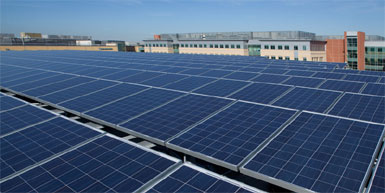On the heels of Google, Apple and GM‘s announcements on renewable energy buys, Kaiser Permanente says it is purchasing enough wind and solar to supply half the electricity it uses in California.
Kaiser is buying the other half of NextEra‘s Altamont Pass project that Google bought into. They are each buying 43 megawatts (MW) from the newly repowered wind farm, Golden Hills.
For solar, Kaiser is purchasing 110 MW from California’s Blythe Solar Power Project, also owned by NextEra. Kaiser is also buying 70 MW of on-site solar from NRG Energy, adding as many as 170 rooftop and ground-mounted arrays at hospitals and campuses in California. In both situations, Kaiser is buying the energy under a 20-year power purchase agreement.
Originally planned as an eye-popping 1 gigawatt concentrating solar project, Blythe has been reduced in size to 485 MW, and changed to solar PV.
Kaiser expects to begin receiving all this energy toward the end of next year. The projects will cut the non-profit health care group’s greenhouse gas emissions 30% (from 2008 levels), meeting its 2020 goal three years early.
11 MW of onsite solar is already installed on hospitals and other buildings in California, Colorado, Hawaii, and Oregon, and Kaiser buys enough wind energy for all the electricity it uses in Maryland and Washington DC. Kaiser ranks #14 among corporate users of renewable energy, so these new buys will move them near the top.
Solar over a parking garage at a Kaiser facility in California:

"Climate change isn’t a distant threat," says Kathy Gerwig, Environmental Stewardship officer for Kaiser. "The health impacts of a changing climate can be felt today in the form of increasing rates of asthma and other respiratory ailments, spread of infectious diseases, heat stress, and injuries from severe weather events. By addressing climate change for the future, we are improving the health of communities today."
Her new book "Greening Health Care: How Hospitals Can Heal the Planet," addresses the health care industry’s considerable environmental footprint and what innovative organizations, NGOs and others are doing to make hospitals healthier places.
Kaiser says it partnering with Health Care Without Harm and the new Business Renewables Center to help the health care industry and the entire US business sector move toward clean energy.
With 38 hospitals, over 600 medical offices, warehouse and administrative space, Kaiser uses nearly 1.5 billion kilowatt hours of electricity a year, and emits 806,000 metric tons of greenhouse gases. As a result of these energy buys and efficiency upgrades, emissions will drop 30% by 2017, even while expanding health care services to patients and communities.
"The energy we use to run our medical centers and other buildings produces the majority of our greenhouse gas emissions," says Rame Hemstreet, Chief Energy Officer. All new buildings will be certified LEED-Gold under LEED for Health Care.
Kaiser also leads using green materials, banning flame retardants in furniture, polyvinyl chloride (PVC) in carpets and flooring, and even working with manufacturers to develop PVC-free building products. It’s been leading on reducing toxic chemicals and on using electronic medical records, which also has positive environmental benefits.
The healthcare industry is responsible for 8% of US greenhouse gas emissions and is second only to the food industry in the waste it generates, much of it classified as hazardous.
Read our article, Greening Hospitals Would Cut Health Care Costs.

